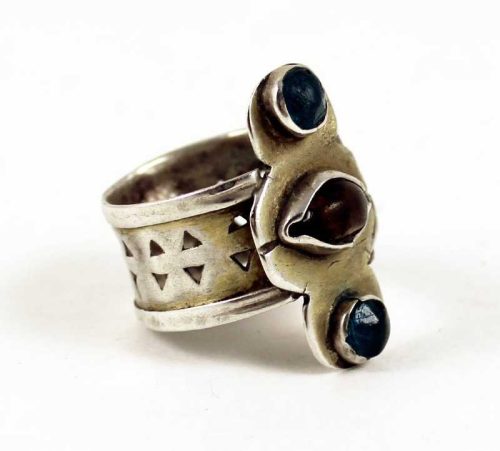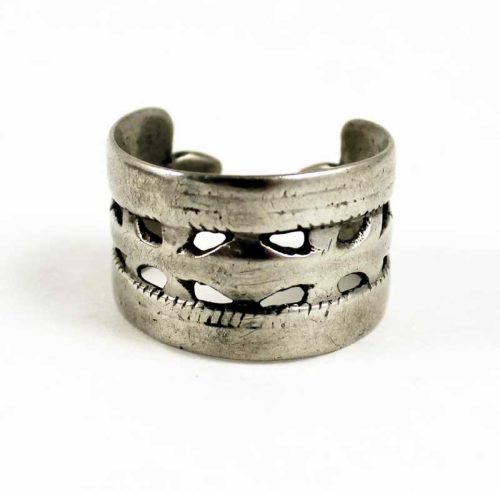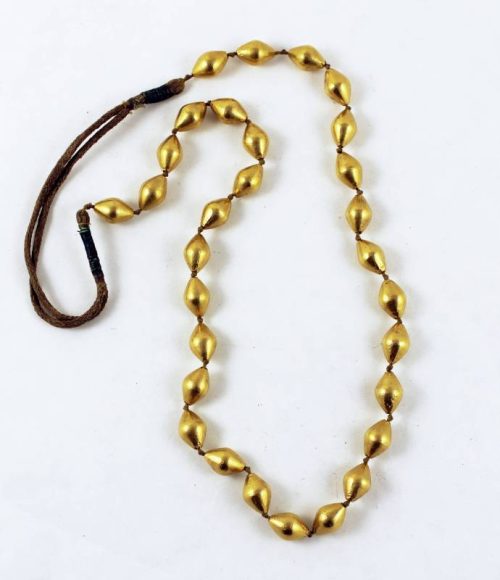-
A five-strand necklace that is usually worn in Southern Uzbekistan in an area where ethnic Uzbek, Tajik, and Pamir live. Made of silver, coral, shell and glass beads. Date: first half of the 20th century or earlier. Dimensions: Length: 84 cm Central pendant: 4,5 x 2 cm Weight: 179 gr Literature: “Schmuck aus Zentralasien”, Prokot, Inge and Joachim Callwey, Verlag München, 1981 “Il corallo. Nell’ornamento dell’Asia islamica dalla Turchia all’Uzbekistan”, del Mare, Cristina- Vidale, Massimo, Electa napoli, 2001 “Kyrgyzstan. Ethnic jewellery of Central Asia”, Kadyrov, V., Rarity Firm LTD, 2007 “De kracht van Zilver. Etnische sieraden uit de collectie smith hutschenruyter”, Mols, Luitgard, Wereld Museum, Rotterdam, 2011
-
Silver filigree ring from Yemen, with dangles to ward off the evil eye and one coral bead at the top of one of the domes (the other one is missing). Beginning of the 20th century or earlier Provenance: European private collection. Size is US 9 - 19 mm inner diameter. Literature: “Bagues ethniques d'afrique, d'Asie et d'Amerique”, van Cutsem, Anne, Skira, 2000, p. 98 ME279
-
Silver ring, worn by Turkoman people, Central Asia. Materials: high grade silver, gilded silver, and glass. From the first half of the 20th century. Provenance: European private collection. Size: US 8 1/4 - 18,25 mm (inner diameter) Width of the top: 2,5 cm Literature: “Bagues ethniques d'afrique, d'Asie et d'Amerique”, van Cutsem, Anne, Skira, 2000, p. 112 “Schmuck aus Zentralasien”, Prokot, Inge and Joachim Callwey, Verlag München, 1981, p. 142 “Der Turkmenenschmuck”, Rudolph, Hermann, Museum für Völkerkunde, 1984, p. 251 “Old silver jewellery of the Turkoman”, Schletzer, Dietrich Reimer Verlag, 1984, p. 258 CA246
-
Silver ring, worn by Turkoman people, Central Asia. Materials: high grade silver, gilded silver, carnelian and glass. From the first half of the 20th century. Provenance: European private collection. Size: US size 9 - 19 mm (inner diameter) Width of the top: 3,5 cm Literature: “Bagues ethniques d'afrique, d'Asie et d'Amerique”, van Cutsem, Anne, Skira, 2000, p. 112 “Schmuck aus Zentralasien”, Prokot, Inge and Joachim Callwey, Verlag München, 1981, p. 142 “Der Turkmenenschmuck”, Rudolph, Hermann, Museum für Völkerkunde, 1984, p. 251 “Old silver jewellery of the Turkoman”, Schletzer, Dietrich Reimer Verlag, 1984, p. 258 CA248
-
Silver ring, worn by Turkoman people, Central Asia. Materials: high grade silver, gilded silver, carnelian and glass. From the first half of the 20th century. Provenance: European private collection. Size: US 8 1/4 - 18,5 mm (inner diameter) Width of the top: 3,5 cm Literature: “Bagues ethniques d'afrique, d'Asie et d'Amerique”, van Cutsem, Anne, Skira, 2000, p. 112 “Schmuck aus Zentralasien”, Prokot, Inge and Joachim Callwey, Verlag München, 1981, p. 142 “Der Turkmenenschmuck”, Rudolph, Hermann, Museum für Völkerkunde, 1984, p. 251 “Old silver jewellery of the Turkoman”, Schletzer, Dietrich Reimer Verlag, 1984, p. 258 CA245
-
High grade silver ring, worn by Turkoman people, Central Asia. From the first half of the 20th century. Provenance: European private collection. Size: US 11 - 20,75 mm (inner diameter), although it can probably be made a little bigger or smaller, as it is an open ring. Width: 1,5 cm CA231
-
A silver amulet from Libya, in the shape of a cylinder and with vegetal and floral decoration etched and embossed on the surface. Some coral beads and small pendants intensify the amulet's power to ward off the evil eye. These containers usually hold written amulets or Ketiba in the form of verses from the Koran or undecipherable phrases appeasing formulas or spells. They may also hold perfumes. The container opens on one of the sides. High grade silver and coral. With a Tripoli silver hallmark on top. From the first half of the 20th century. Dimensions: Length of the chain: 64 cm Size of the pendant with dangles: 9 x 11 x 2,5 cm Weight: 118,2 gr Literature: "Libyan jewellery", Schenone Alberini, Elena, Araldo De Luca Editore, 1998, p. 70 "Jewelry and Adornment of Libya", Ghellali, Hala, BLKVLD, 2024, p. 102 TUN11
-
Old Central Asian silver ring, inset with light and dark blue glass beads. High grade silver. From the first half of the 20th Century. Provenance: UK private collection. The size of the ring is 8 3/4 american size or 18,75 mm inner diameter. CA232
-
Old Central Asian silver ring, inset with small blue glass beads. Some arabic inscriptions are embosed on the top, maybe some amuletic words to ward off the evil eye. The color blue would also serve to the purpose. High grade silver and blue glass beads. It is a massive silver ring, no hollow parts. From the first half of the 20th Century. The size of the ring is US 7 3/4 - 18 mm inner diameter CA239
-
Rare Minangkabau necklace, from West Sumatra, Indonesia. The necklace is made of gilded high grade silver (tested) and terracotta beads. From the first half of the 20th century. Dimensions: Length: 60 cm Size of the each pendant: 6,5 x 6 cm Weight: 34,6 gr Literature: “Ethnic Jewelry from Indonesia”, Carpenter, Bruce W., Editions Didier Millet, 2011 “Gold Jewellery of the Indonesian Archipelago”. Anne Richter, Bruce W. Carpenter, ed.Didier Millet, 2011, p. 285 INDO146
-
Turquoise silver Tibetan ring with nice patina, in a square shape. Pearls, turquoise coral and amber are very important for Himalayan adornment culture, as they are believed to have prophylactic properties. That's why they use them on necklaces, bracelets rings and head adornments. From the first half of the 20th century. The size of the ring is US 8 1/4 (18,5 mm inner diameter). The top of the ring is 1,8 x 1,8 cm. HIM145
-
Vintage Indian gold necklace. These olive-shaped beads are made with 22kt gold sheets wrapping a wax core. From the second half of the 20th century. Provenance: European private collection. Dimensions: Size of the beads: 1,5 cm Total length: 62 cm Weight: 27,6 gr IND1715












